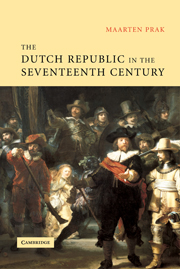Book contents
- Frontmatter
- Contents
- List of illustrations
- Acknowledgements
- Chronology
- Map
- Introduction: The enigma of the Republic
- 1 A turbulent beginning
- Part I War without end
- 2 An independent state (1609–1650)
- 3 A world power (1650–1713)
- 4 The armed forces
- 5 Financial might
- Part II Golden Age: economy and society
- Part III Unity and discord: politics and governance
- Part IV An urban society
- Conclusion: The end of the Golden Age
- Further reading
- Index
2 - An independent state (1609–1650)
Published online by Cambridge University Press: 05 February 2015
- Frontmatter
- Contents
- List of illustrations
- Acknowledgements
- Chronology
- Map
- Introduction: The enigma of the Republic
- 1 A turbulent beginning
- Part I War without end
- 2 An independent state (1609–1650)
- 3 A world power (1650–1713)
- 4 The armed forces
- 5 Financial might
- Part II Golden Age: economy and society
- Part III Unity and discord: politics and governance
- Part IV An urban society
- Conclusion: The end of the Golden Age
- Further reading
- Index
Summary
In 1609, at the beginning of the Twelve Years' Truce, the young Republic was still a country with a split personality. The coastal provinces, which were experiencing spectacular economic growth, were overrun with immigrants, fleeing the violence elsewhere or in search of a better life. Ever since the Spanish had vacated Geertruidenberg after the Dutch recaptured it in 1593, the violence of war had been nothing more than a frightening memory and a financial burden to the people of Holland. The inhabitants of Friesland and Zeeland could also reckon themselves safe. In the inland provinces, however, people were still suffering from the ravages of war. Twente was in Spanish hands and would remain so for years to come. Groenlo was still Spanish, whereas the rest of the county of Zutphen had already surrendered to the States General. Elsewhere, too, the borders were in dispute. Limburg lay completely outside the authority of the States General. The Republic occupied the north-western tip of the duchy of Brabant, including Bergen-op-Zoom and the Orangist city of Breda, but 's-Hertogenbosch and the Meierij (one of the four parts of the duchy of Brabant) were completely under the authority of the king of Spain. By contrast, States Flanders (the part of Flanders now known as Zeeuws-Vlaanderen) was controlled by the Republic.
- Type
- Chapter
- Information
- The Dutch Republic in the Seventeenth CenturyThe Golden Age, pp. 27 - 44Publisher: Cambridge University PressPrint publication year: 2005



